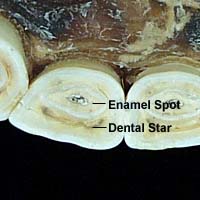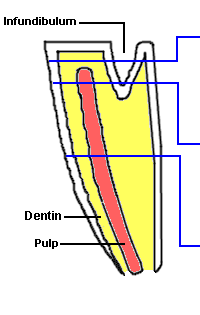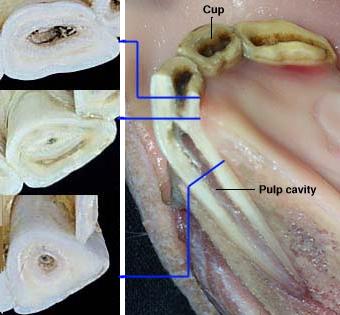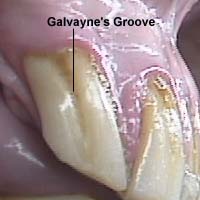VIVO Pathophysiology
Aging Horses by Their Teeth
Estimating the age of a horse by examining its teeth is a common practice. For very young horses, eruption dates are useful, but in general, the place to start is examination of the occlusal surface of the lower incisors. Similar changes occur on the upper incisors, but it is typically easier to get a good look at the lowers. Two characteristics should be noted:
|
Shape of the incisors: For horses less than about 11 years, all of the lower incisors have a rounded, oval shape. As the horse gets older, the surface of the incisors changes, first to a triangular shape and finally a rectangular shape. Cups, stars and spots: The cup is the center of the infundibulum. Wear of the occlusal surface causes the cup to get smaller and eventually disappear from all lower incisors at about 8 years of age leaving the enamel spot in its place. The enamel spot is the deepest part of the infundibulum. The dental star corresponds with the pulp cavity and appears at 8 years of age in the first incisor. It appears as a line and then changes to a large, round spot as the occlusal surface is worn further. It is still visible after the cup and enamel spot have been worn away. |
 |
  |
|---|
|
The anatomic relationships between incisor anatomy and the cups and stars seen on the occlusal surface as they wear are depicted in the images and diagrams immediately above. The image on the right is shows an incisor of a young horse cut longitudinally while still in the jaw. |
|
Another dental feature useful for aging older horses is Galvayne's groove. As shown in the image to the right, Galvayne's groove is located on the lateral surface of the upper third incisor. It appears first near the gum line at about 10 years of age. The groove extends halfway down the tooth at 15 years, and all the way down the tooth by 20 years. By approximately 25 years, Galvayne's groove is halfway gone, and by 30 years, it has disappeared completely. |

|
| Tooth Eruption | |||
|---|---|---|---|
| Temporary | Permanent | ||
| Incisors | d1= 6 days | I1= 2.5-3 years | |
| d2= 6 weeks | I2 = 3.5-4 years | ||
| d3= 6 months | I3= 4.5-5 years | Canine | 4-5 years |
| Wear of Permanent Teeth | |||
|---|---|---|---|
| I1 | I2 | I3 | |
| Smooth (cups gone) | 6 years | 7 years | 8 years |
| Stars | 8 years | 9 years | 10 years |
| Round | 9 years | 10 years | 11 years |
| Triangular | 16 yrs | 17 yrs | 17-18 yrs |
| Rectangular | 18-20+ yrs | ||
Author: Melissa Rouge
Send comments to Richard.Bowen@colostate.edu
